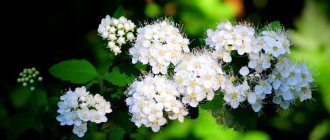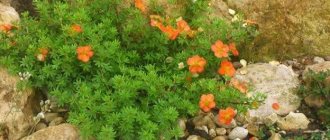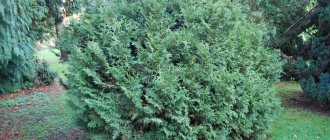Spiraea loosestrife is an interesting ornamental plant. The botanical name comes from the ancient Greek word “speira”, which means “bend”, “spiral”. This is explained by the fact that long, flexible branches give the shrub additional splendor. The second word in the name is derived from the shape of the leaves, which are similar in appearance to willow leaves. A description and photo of willow spirea will be presented below.
General description of the plant
Spiraea loosestrife belongs to low shrubs (the maximum height of the bush reaches 2.5 m), and attracts gardeners with its picturesque and graceful inflorescences of white and pink shades. It is distinguished by a dense and round crown, ribbed shoots, and lanceolate leaves. The average length of leaf blades varies between 5-11 cm in length, and from 1 to 3 cm in width. The plant blooms with bells collected in panicles. The length of the inflorescences reaches 25 cm.
Spiraea begins to bloom at the age of 4-5 years, with white or pink flowers. In the wild, it grows in Europe, Asia, and North America. Like willow, this shrub prefers to grow on the banks of rivers and lakes, near swamps and in other well-moistened places. The culture is frost-resistant, characterized by rapid growth and ease of care.
Attention : flowering of willow spirea begins in early summer and ends in autumn.
Use in landscape design
The diversity of species allows the use of spirea in landscapes of different directions: Japanese, English, rural, pastoral, French, Russian. Low-growing species are used to create borders along garden paths and colorful curtains in green meadows.
Their root system perfectly tolerates cramped growth conditions, so plants of small habit are used in mobile landscaping of terraces, paved courtyards, patios, and pool areas.
Landscape designers use tall spirea as solitary plants, planting the bushes at a fairly large distance from one another. In this design, they look great on mowed lawns, without requiring additional decorative planting.
Free-growing hedges are picturesque, most often made up of one, less often several types of spirea.
Blooming spirea in flower beds
Spiraea are not afraid of gas pollution on city streets, so they are successfully used in landscaping parks and squares. They can often be seen in flower beds planted at the entrance to large supermarkets, entertainment venues, and administrative offices.
Popular varieties
White willow spirea does not have a wide variety of varieties. But it pleases flower growers with luxurious crowns, lush flowering and various forms. It got its name due to its resemblance to willow. Since its leaves are just as pointed, long and colored in two colors (dark green on top, lighter below).
According to the flowering time, spirea is classified into:
- spring blooming . The flowers bloom on it in the spring and are grouped into umbrella-shaped inflorescences. These varieties bloom magnificently and abundantly throughout the month;
- summer flowering . Their shape is most often paniculate or pyramidal. The flowers are pink and purple, but not as lush as early-blooming varieties. But these varieties delight owners with longer flowering periods (more than a month).
The most popular varieties of willow spirea include:
- Alba . The bush grows up to 2 m in height, has a wide and oval crown. The shrub grows quite quickly. Translated from Latin, alba means “white”. Consequently, the plant pleases owners with abundant snow-white blooms on paniculate inflorescences. White bells on the plant bloom on young shoots at the end of June, and bloom throughout the month. This variety lends itself well to pruning while maintaining its decorative properties. Any garden soil is suitable for it. The main thing is to choose a well-lit place where there is less direct sunlight.
- Grandiflor . The shrub grows up to 2 m in height. It is distinguished by erect shoots, a dense and round crown, and a solid surface of the leaf plates. With the onset of autumn, the top of the bush becomes orange-red. This variety is classified as large-flowering. Its inflorescences reach 20 cm in length. The panicles themselves are cylindrical with light pink inflorescences. The bush blooms for 3-4 weeks. This variety is unpretentious in care. The plant grows quite quickly, and its lifespan is 15-20 years.
- Billard . It belongs to the late-flowering hybrids of willow spirea, the height of which reaches 2.5 m. Its shoots are spreading, straight and completely covered with foliage. The leaves below are distinguished by a gray tint, and with the onset of autumn, they acquire a brown-red color. Billarda's buds are not too large, but they smell pleasant. This variety blooms with thick and narrow panicles, the length of which reaches 20 cm. The flowering of spirea is abundant, lush and colorful (blooms with bright pink flowers). It begins at the end of summer and continues until mid-autumn. This variety is frost-resistant, tolerates drought well and loves light.
- Van Gutta . A bush up to 2.5 m high, which blooms 2 times a season (early spring and late June). During flowering, the plant is covered with double white flowers, up to 7 cm in diameter.
Appearance and biological features
Plants of this genus can grow both small (up to 15 cm) and tall (up to 2.5 m). The branches of the bush are erect or creeping. The color ranges from light to dark brown. The roots are shallow and fibrous. During flowering, spirea is covered with numerous small flowers in inflorescences of different shapes. The color of the petals ranges from snow-white to crimson. Spiraea inflorescences can be located throughout the shoot, or on its upper part or at the end of the branch. The plant propagates by seeds, cuttings, dividing the bush, and layering.
Spirea does not need pruning. It is carried out exclusively for decorative purposes, to give the bushes a more aesthetic appearance. The crown of a plant can be thick and dense or slightly “sparse”, but it always looks attractive. The branches bloom right down to the ground, so there is no unsightly “bare leg” effect.
The shrub is hardy, adapts well to various climatic conditions, so it can be grown not only in the south or in the middle zone, but also in the northern regions. If the spirea freezes slightly in severe frosts, then after pruning it is completely restored and blooms in the same year. For normal development of the plant, a few hours a day of direct sun, fertilizing, and good soil are enough. You don’t have to cover it for the winter
Spiraea blooms on shoots that grow during the same year, so pruning does not spoil its appearance
Planting and caring for willow spirea
Willow spirea is not at all fussy about care, but for good growth of the bush the following rules must be followed:
- the plant is planted in the ground in the spring, before buds begin to form on the shoots;
- The planting location is selected depending on the plant variety. This may be partial shade or a well-lit area;
- For planting in open ground, the soil is prepared in advance. The plant needs soil consisting of soil, sand and peat;
- the optimal planting scheme is calculated. This can be either a solo landing or a group landing.
Attention : the ideal time to plant spirea in the ground is early morning or late evening. It is also good to plant in rainy and cloudy weather.
Selecting a location
The choice of place for planting spirea directly depends on its variety and type. Some shrubs like partial shade, others sunny and well-lit areas. It is best to plant spirea next to an artificial pond or in a swampy area where the soil is highly moist.
Pit size, distance between plants when planting
When planting spirea, holes are made twice as large as its root system. The ideal choice would be holes with dimensions of 50x50 cm. The roots are spaciously placed in the holes, and the soil around the seedling is pressed down and watered. If we are talking about group plantings, then the distance between the bushes is 0.5 - 1 m.
Attention : spirea roots grow strongly. Therefore, when planting a plant in a group planting, it is worth maintaining a sufficient distance.
Watering
White and pink willow spirea requires thoroughly moistened soil. Once a week it needs to be watered abundantly (about 20 liters per plant). In severe drought, watering the bush increases. This is due to the fact that the roots of the plant are located close to the surface and during severe drought the plant experiences stress.
Attention : young plants need to be watered well and regularly until they take root.
Fertilizer and feeding
Planting and caring for willow spirea comes down to good fertilizer and feeding. Fertilize the shrub in the spring, before the first buds appear on it. Organic and mineral fertilizers are used as fertilizers.
Attention: when planting a bush on fertile soil, it may not need additional feeding for several years.
Trimming
Spiraea loosestrife in landscape design requires periodic pruning. This process is mandatory when creating a beautiful appearance of the bush. Willow spirea is pruned in autumn or early spring, before buds begin to form on the bushes. Old plants are cut back to the stump. Only the 5 most viable shoots are not cut off from them. But the crown of the plant is pruned abundantly. Because it is growing at a rapid pace.
Attention : only bushes that have reached 4 years of age can be pruned. Faded shoots cannot be pruned. Since the plant will produce new side stems, which will subsequently bear small and pale inflorescences.
Main types of spirea
In accordance with the description of spirea, the shrub is divided into classifications depending on flowering time. The landing characteristics, as well as the appearance that can be seen in the photo, depend on this.
- Spring flowering shrubs. They produce flowers in late spring or early summer. The flowers are very beautiful, usually colored in different variations of white.
- Summer flowering. Their inflorescences form on the tops of young shoots. The flowers are usually pink, but can also be pinkish-red or just red.
Reproduction methods
Willow spirea reproduces in several ways:
- Seeds . They are sown in a pot in early March. The first shoots appear after 2-3 weeks. After 3 months, the plants are picked and planted in open ground. With the right approach to propagating spirea by seeds, the shrub will begin to bloom in 2-3 years.
- By cuttings . This is the most common method that allows you to preserve all the characteristics of the variety. With this method of propagation, the bush begins to bloom the very next year. Woody branches up to 15 cm long are used as cuttings. Their lower cut is treated with special preparations that stimulate the formation of roots and are planted in the ground. Reproduction of spirea by cuttings is carried out in mid-summer, then their root system will be fully formed by autumn.
- By layering . To do this, the side shoots of the plant are bent to the ground and dug in. With regular watering, the buried branches will take root fairly quickly, and they can be separated from the main bush and planted separately in the soil.
- Dividing the bush . In the fall (after the plant has flowered), it is dug out of the ground and the bush is divided into several parts with sharp pruning shears. Next, the plant is planted in the ground in a previously prepared place.
Landing
Spiraea is considered an unpretentious shrub. She will not need much attention in matters of planting. However, some points should be followed for the good development of the plant.
Planting shrubs can be done both in autumn and spring. In the spring, you need to be in time before the buds appear on the bush. And in the fall, after the leaves have fallen. The site for the future bush should be in an open place, protected from cold winds and with sufficient sunlight. It is worth remembering that it is best to plant a seedling in rainy weather.
Landing algorithm:
- We dig a hole about fifty centimeters deep.
- Place leaf humus at the bottom of the hole.
- We plant a seedling. For better growth of the shrub, its roots should fit freely into the hole.
- Water with three liters of warm water.
- Fill with soil and tamp lightly.
In the first week after planting, daily watering and weed removal are required. Mulching with sawdust or straw will help retain moisture in the soil.
Diseases and pests
Spiraea loosestrife is quite resistant to various pests and diseases. However, it is recommended to regularly inspect the bush for damage to the following insects:
- spider mite . It damages the inflorescences and causes them to wilt. The pest is especially common on bushes during very hot summers;
- aphids . It sucks out all the juices from the plant, which leads to drying out of the bush;
- leaf roller It attacks bushes in early May and eats leaves.
Care
The whole process of caring for a plant mainly consists of constant watering, fertilizing and pruning bushes.
Spiraea loosestrife requires timely and moderate watering. During drought, one bush receives about 15 liters of water per week.
The best time for fertilizing is considered to be the spring, namely the time before the bush begins to flower. A bucket of manure and five buckets of water are used as top dressing. Ten grams of superphosphates are added to a bucket of the mixture.
Pruning branches is useful both for decorative quality and to improve the flowering quality of the plant. Pruning is done with the arrival of spring so that the plant has time to recover before the flowering season.
Combination with other plants in the garden
Spiraea loosestrife is found quite often in landscape design. Since it is unpretentious in care, it pleases with abundant and colorful flowering. This shrub looks great in both solo and group flower arrangements. It is often used when planting hedges, borders, and mixboards.
Attention: when forming a hedge, taller varieties of spirea are selected. And when creating beautiful borders, preference is given to low-growing varieties.
When combining different varieties of willow spirea, it is important to take into account the color of its leaves, the height of the bush, the color of the inflorescences, and the flowering period. Then you will be able to create spectacular and unusually beautiful compositions on your personal plot. For mono plantings, bushes with densely blooming bright flowers are selected.
Important : white willow spirea harmoniously combines with various shrubs and flowering plants.
In conclusion, it is worth noting that spirea is an excellent plant for the garden. It is completely unpretentious in care, has long and abundant flowering, and is suitable for decorating various colorful flower beds.
Healing properties
Spiraea loosestrife is endowed with a whole range of medicinal properties in its chemical composition.
- Ascorbic acid helps improve immunity and strengthen the walls of blood vessels.
- Carotenoids are able to stop the aging of cells in the body.
- Essential oil with salicylic acid. It has analgesic and antipyretic properties.
- Flavonoids activate metabolic processes in the body.
- Tannins.
In folk medicine, the shrub is used as infusions and decoctions. It is used for gastrointestinal disorders, one tablespoon several times a day. The decoction also helps with colds.











